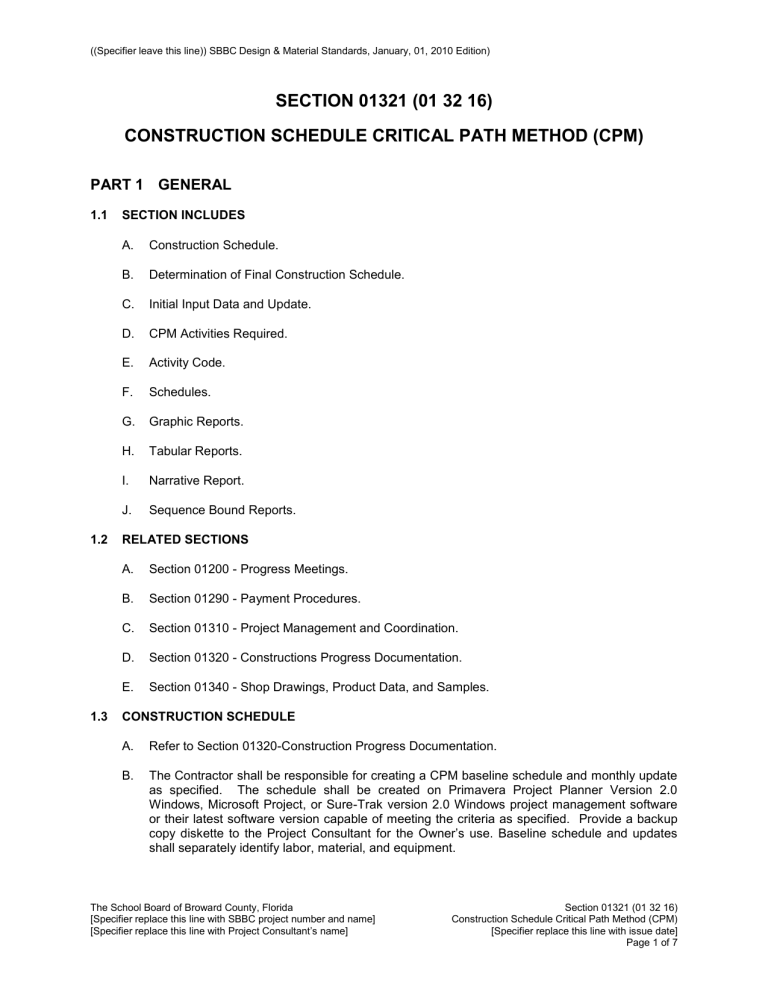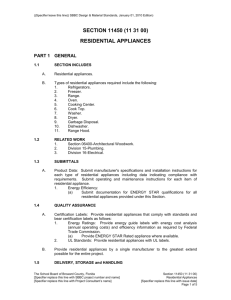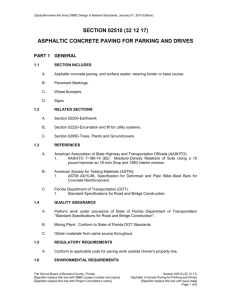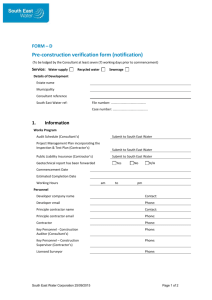Construction Schedule Critical Path Method-CPM

((Specifier leave this line)) SBBC Design & Material Standards, January, 01, 2010 Edition)
SECTION 01321 (01 32 16)
CONSTRUCTION SCHEDULE CRITICAL PATH METHOD (CPM)
PART 1 GENERAL
1.1 SECTION INCLUDES
A. Construction Schedule.
B. Determination of Final Construction Schedule.
C. Initial Input Data and Update.
D. CPM Activities Required.
E. Activity Code.
F. Schedules.
G. Graphic Reports.
H. Tabular Reports.
I. Narrative Report.
J. Sequence Bound Reports.
1.2 RELATED SECTIONS
A. Section 01200 - Progress Meetings.
B. Section 01290 - Payment Procedures.
C. Section 01310 - Project Management and Coordination.
D. Section 01320 - Constructions Progress Documentation.
E. Section 01340 - Shop Drawings, Product Data, and Samples.
1.3 CONSTRUCTION SCHEDULE
A. Refer to Section 01320-Construction Progress Documentation.
B. The Contractor shall be responsible for creating a CPM baseline schedule and monthly update as specified. The schedule shall be created on Primavera Project Planner Version 2.0
Windows, Microsoft Project, or Sure-Trak version 2.0 Windows project management software or their latest software version capable of meeting the criteria as specified. Provide a backup copy diskette to the Project Consultant for the Owner’s use. Baseline schedule and updates shall separately identify labor, material, and equipment.
The School Board of Broward County, Florida
[Specifier replace this line with SBBC project number and name]
[Specifier replace this line with Project Consultant’s name]
Section 01321 (01 32 16)
Construction Schedule Critical Path Method (CPM)
[Specifier replace this line with issue date]
Page 1 of 7
((Specifier leave this line)) SBBC Design & Material Standards, January, 01, 2010 Edition)
C. Within 30 days of Notice of Award, prepare and submit to Project Consultant and the Owner a proposed construction schedule for review. No payments shall be made to Contractor until said schedule has been submitted and approved.
D. Schedule Approval:
1. The form and content of the schedule and reports prepared shall be subject to the approval of the Project Consultant and the Owner.
2. Said approval relates only to complying with scheduling specifications and not to construction means and methods.
3. Contractor ’s invoices shall not be processed until baseline schedule and current update are approved.
4. Schedules and durations of any activities and labor efforts required to complete activities and labor efforts shall have the agreement of the appropriate following, but not limited to, electrical, mechanical, plumbing, structural, plastering, or fire alarm subcontractors.
5. The baseline schedule shall be signed by each of the aforementioned subcontractors indicating agreement with the durations.
(a) Those listed subcontractors shall be also required to sign the most current schedule update starting 1 month before their mobilization on the job site, indicating their agreement or disagreement with that current updated schedule.
(b) Failure of a subcontractor to agree with this schedule shall serve as notice to the
Contractor of potential schedule difficulties.
(c) Under no circumstances shall the disagreement by a subcontractor be cause for excusable or compensatable delay for the Contractor. The full responsibility for completing the project on time remains with the Contractor.
E. Critical Activity Flags/Milestones:
1. Contractor shall identify project flags or milestones occurring at the completion of significant events including, but not limited to, BCI or other inspections, completion of major systems or assemblies, or substantial or partial completion dates for each area.
2. Flags shall occur at appropriate intervals of approximately each month.
3. The flags shall be located on the critical path and be incorporated into the baseline, all targets, and the current schedule.
4. A flag for Contract Award shall have an Activity ID of 00040V.
5. Each succeeding flag shall increment the last two digits by one.
6. No flag shall have an activity ID higher than 00099V.
7. Flags shall be the first grouping to appear on any schedule layout.
F. Resource Dictionary:
1. Resource crews shall be loaded into the resource dictionary by CSI divisions.
2. Each trade crew shall be identified by a CSI related crew code consisting of the first 3 digits of the appropriate CSI code for the work being performed.
3. The type of resource shall be identified as follows, LAB = Labor, MAT = Material, and EQU =
Equipment. (I.e., 010LAB for General Conditions, 022LAB for Earthwork, 033LAB for
Concrete, etc.)
4. Each resource crew or equipment type shall have reasonable resource limits as established by the appropriate subcontractor as to the normal and maximum number of resources available per day (Labor = Person days, Material = Units, Equipment = Units). Resource budgeted quantities and units per day shall be established for each task and each resource set, as a driving resource so the duration of the task is dependant on the quantities assigned.
5. A forward leveled resource run shall be required for baseline acceptance, proving the defined resources can complete the project/phases at the required time.
6. The Contractor ’s superintendent shall use resource-loading reports to insure appropriate numbers of subcontractor personnel are available as work progresses on the project.
The School Board of Broward County, Florida
[Specifier replace this line with SBBC project number and name]
[Specifier replace this line with Project Consultant’s name]
Section 01321 (01 32 16)
Construction Schedule Critical Path Method (CPM)
[Specifier replace this line with issue date]
Page 2 of 7
((Specifier leave this line)) SBBC Design & Material Standards, January, 01, 2010 Edition)
G. Cost Accounts:
1. Cost Account Numbers may be established using the appropriate 5-digit CSI number and a cost category code (L=Labor, M=Material, E=Equipment, O=Other). A file containing acceptable CSI codes is included in the available sample project diskette.
H. Activity Codes:
1. The following table identifies the Board’s required activity codes. The Contractor may use additional codes for its own requirements.
(a) ACTIVITY ID# NAME LENGTH DESCRIPTION
(b) 1
(c) 2
CSI 3
STEP 2
CSI Code
Increment to make CSI Unique.
(d) 3
(e) 4
BLDG 1
SUBA 4
Building/Area
Sub Area/Floor
(f)
(g) ACTIVITY CODE# NAME LENGTH DESCRIPTION
(h) 1
(i) 2
(j) 3
(k) 4
(l) 5
(m) 6
PHAS 1
DIV
CRIT
2
PROJ 8
RESP 2
1
TYPE 1
Phase
CSI Division
SBBC Project Number
Responsible Party
Critical Flag or Milestone
Task Type
I. Schedule Content:
1. Whenever there is a logical inconsistency in the schedule content, such as insufficient resources to complete tasks within the allotted time, mandatory date constraints that override logical constraints, out of sequence progress, etc., correct the schedule to eliminate the inconsistency.
2. All imposed constraints shall be explained by a log entry in the appropriate task.
3. All tasks shall be scheduled as early as possible unless specific tasks are required to be scheduled otherwise.
1.4 DETERMINATION OF FINAL CONSTRUCTION SCHEDULE
A. Contractor shall identify on the schedule:
1. Any consideration given for working other than normal working hours.
2. Schedule impacts due to school operation.
3. Work required by others that impact the Contractors efforts.
B. Any such impacts shall be approved in writing by the Owner.
1.5 INITIAL INPUT DATA AND UPDATE
A. Provide initial input data and update monthly to Project Consultant relating to actual work activities accomplished for forecasting future work activities and durations.
1. Report problem areas to Project Consultant, including current, unresolved or anticipated delay factors and impact on other activities and what control steps are being taken or planned.
2. Review monthly progress and recommend ways to improve schedule or anticipate delays and safety problems.
3. Inform and update participants of revisions to construction schedule.
4. Submit revised schedule each month concerning future construction activities.
5. All reports submitted to the Owner, except logic reports, shall be printed on 8.5 inch x 11 inch paper and bound into a completed report with cover page identifying project number, project description, school name, and Contractor according to Article 1.12 this section.
The School Board of Broward County, Florida
[Specifier replace this line with SBBC project number and name]
[Specifier replace this line with Project Consultant’s name]
Section 01321 (01 32 16)
Construction Schedule Critical Path Method (CPM)
[Specifier replace this line with issue date]
Page 3 of 7
((Specifier leave this line)) SBBC Design & Material Standards, January, 01, 2010 Edition)
6. The bound report, shall be submitted in support of the Contractor ’s requisition for payment, shall include:
(a) Contractor ’s narrative report.
(b) Copy of Contractor ’s requisition for payment.
(c) All required scheduling reports.
1.6 CPM ACTIVITIES REQUIRED
A. CPM schedule shall contain between 500 and 2500 activities, including submittal/approval/fabrication tasks and shall account for the entire duration of the allocated
Contract time. Early completion shall not entitle Contractor to acceleration.
1. The Owner may require the addition of up to 100 tasks into the schedule and reports in addition to the tasks that are the responsibility of the Contractor.
2. Activities relating to the projects total duration, such as General Conditions or supervision, shall be established, as a hammock type so earned value shall always equate to percentage completion of the entire project.
3. Each updated schedule shall be displayed in Contractor ’s Field office in monthly update bar chart format according to Article 1.9 A.4 this section.
4. Adjustments to phasing requirements shall be reflected in subsequent schedule updates, at no cost to the Board.
5. The baseline schedule and all monthly updates shall delineate a continuous critical path, through detail construction work items, from the data date to the completion of the project.
B. Schedule long lead time and special fabrication items and provide appropriate selection codes incorporated into each item to include, as a minimum, the following categories:
1. Submittal.
2. Approval.
3. Fabrication/Delivery.
4. Installation.
C. Code each task to allow selection for preparation of or exclusion from any given set of reports.
All reports after the initial reports shall have the submittal, approval, and fabrication tasks segregated from the installation tasks, at the discretion of the Board.
D. Installation tasks shall be cost loaded to include the cost of equipment (RESOURCE code = xxxEQU), cost of materials (RESOURCE code = xxxMAT), installed and cost of labor
(RESOURCE code = xxxLAB).
1. The person hours required to complete the task shall be inserted as budgeted quantity
(Resource Code = xxxLab) and the units per time period and driving resource shall be completed.
2. The costs are the Owner’s costs and shall tie to the schedule of values approved by CSI
Divisions.
E. Schedule all BCI tasks and tasks identifying the production monthly reports.
F. Schedule task to have a maximum original duration of 20 days except for procurement tasks that may be 30 days without including a follow up task.
G. Schedule tasks identifying the production of monthly updating reports.
H. Schedule tasks in working days (5 working days per week) and in precedence format.
I. Include verbs in task descriptions to describe the action taken. For example, use "Install lighting fixtures" instead of "Light fixtures".
The School Board of Broward County, Florida
[Specifier replace this line with SBBC project number and name]
[Specifier replace this line with Project Consultant’s name]
Section 01321 (01 32 16)
Construction Schedule Critical Path Method (CPM)
[Specifier replace this line with issue date]
Page 4 of 7
((Specifier leave this line)) SBBC Design & Material Standards, January, 01, 2010 Edition)
1.7 ACTIVITY (TASK) CODES
A. Code each tasks to minimally define (See Article 1.3 G this section):
1. Area of Work.
2. Applicable CSI division.
3. Party responsible for performing.
4. Area of work including building and floor, if applicable.
5. Phase of project as defined by specifications.
6. Task type, identifying:
(a) Submittals.
(b) Approvals.
(c) Fabrication/Delivery.
(d) Installation.
(e) Administrative.
(f) Other.
7. Critical Flags and Milestones (see Article 1.3 D this section).
1.8 SCHEDULES
A. Designate the approved submitted schedule as the baseline schedule. Produce a schedule that is updated monthly and referred to as the current schedule. Show in a single report, the baseline and current schedules (see Article 1.09 A.4 this section).
B. Each update shall include identification of the actual start and actual finish dates and remaining duration of all tasks started.
C. Each approved Change Order shall be reflected in the current schedule and shall update the previous baseline or target schedule. For example, Change Order 1 when reflected in the baseline shall create Target 1 (updated baseline including Change Order 1), Change Order 2 shall create Target 2, et cetera.
D. Reports requiring comparison between the current schedule and target (updated baseline) shall use the most recent target schedule unless directed otherwise.
E. Primavera’s 4-digit project name shall be supplied to Contractor by the Board for both the baseline and current schedules. These names shall remain consistent throughout the life of the project. Each target and each monthly update of the current schedule shall be backed up on CD-Rom format and appropriately labeled and retained until completion of the project and final payment. Supply a copy of each diskette on a monthly basis to the Owner monthly, with the Application for Payment. The application number and data date shall be inserted in the
"Number/Version" field in this format: 01-04/15/02.
F. Each monthly update shall be reviewed for "out of sequence progress" and if logic errors exist, they shall be corrected either by physical adjustment, or by using "progress override" method of scheduling.
1.9 GRAPHIC REPORTS
A. Reports shall be by area and sub area of work. In addition to the reports specified below, the
Owner may request a special report(s) to clarify the status of work or logic of construction.
1. Baseline Network Logic Report:
(a) Show all tasks grouped by area, including task number, description, original duration, early start and finish, and total float. This report shall be required to review the underlying logic sequence and dependencies of the various tasks. A similar report is required for each proposed change order to determine the change order's impact.
The School Board of Broward County, Florida
[Specifier replace this line with SBBC project number and name]
[Specifier replace this line with Project Consultant’s name]
Section 01321 (01 32 16)
Construction Schedule Critical Path Method (CPM)
[Specifier replace this line with issue date]
Page 5 of 7
((Specifier leave this line)) SBBC Design & Material Standards, January, 01, 2010 Edition)
(b) Prepare on 24 inch x 36 inch paper.
2. Detailed Time Logic Chart (if required by Project Consultant):
(a) Initial Detailed Time Logic Chart grouped by area showing:
(b) Activity numbers.
(c) Description of activity.
(d) Total float.
(e) Duration.
(f) Prepare on 24 inch x 36 inch paper.
3. S-Curves: Refer to Section 01320-Construction Progress Documentation
4. Monthly Update Bar Chart:
(a) A bar chart comparing current progress to the most recently approved target schedule.
(b) Print on color printer or adjust Primavera grayscale so all shades are readable and meaningful.
(c) Sort the chart by area, early start date, and show the activity ID, original duration, percent complete, total float, baseline late finish, current early finish, budgeted cost, earned value in the tabular portion, and activity description in the bar portion.
(d) Prepare on 8.5 inch x 11 inch paper.
1.10 TABULAR REPORTS
A. Samples of required reports for a hypothetical construction project using the Primavera Project
Planner software are provided at the end of this section. The submitted reports shall be similar to these samples.
B. Furnish the following reports as initial reports from the baseline schedule and with each required payment request from the current schedule. Unless otherwise specified or revised by the Owner organize reports by area of activity and sub-sorted by early start date.
1. Schedule Report:
(a) List the current status of all activities, sorted by activity number from lowest to highest and not by area.
(b) Prepare on 8.5 inch x 11 inch paper.
2. Total Float Report:
(a) List all uncompleted activities sorted by total float and then by early start date.
(b) Prepare on 8.5 inch x 11 inch paper.
3. Earned Value by CSI/Task:
(a) Show the total budget and earned amounts this period and to date for each task.
Payment requests shall be verified from this report. Amounts shall correspond to the
Schedule of Value identified in General Conditions subparagraph 9.01.02. Report shall be organized by area unless otherwise requested.
(b) Prepare on 8.5 inch x 11 inch paper.
4. Cost Summary by CSI Division:
(a) Show division, description, percent complete, construction amount, earned to date, earned this period, balance to complete, and retainage. Prepare on 8.5 inch x 11 inch paper.
1.11 NARRATIVE REPORT
A. A narrative report shall be included in each bound report and submitted with each payment requisition.
B. The purpose of the narrative report shall be to accurately inform the Owner of the current status of the project, any future anticipated problems, delaying factors, and explanation of any corrective actions taken or proposed to mitigate the problems or delays.
The School Board of Broward County, Florida
[Specifier replace this line with SBBC project number and name]
[Specifier replace this line with Project Consultant’s name]
Section 01321 (01 32 16)
Construction Schedule Critical Path Method (CPM)
[Specifier replace this line with issue date]
Page 6 of 7
((Specifier leave this line)) SBBC Design & Material Standards, January, 01, 2010 Edition)
C. If the initial run of any monthly update of the schedule results in negative float, (delay in projected completion date of any phase or final completion) and the project delay can be mitigated by adjusting the schedule through changes in logic or reducing durations of critical items, Contractor may make those changes before the submission of schedule reports provided:
1. A detailed explanation of the amount of negative float and schedule corrective action is included in the narrative report.
2. Changes in duration are realistic and supportable by historic productivity and quantity analyses, if requested by the Board.
3. Logic changes are consistent with standard industry practices.
4. A copy of the original total float report, showing only those activities with negative float, shall be included in the volume of bound reports, along with the entire revised total float report.
1.12 SEQUENCE OF BOUND REPORTS
A. Bound reports presented in support of a requisition for payment shall be inserted in the following sequence:
1. Cover page identifying project location, project number, Contractor, requisition number, date.
2. Narrative report.
3. Requisition summary.
4. Monthly update bar chart.
5. Total float report.
6. Earned value by CSI.
7. Schedule report.
END OF SECTION
The School Board of Broward County, Florida
[Specifier replace this line with SBBC project number and name]
[Specifier replace this line with Project Consultant’s name]
Section 01321 (01 32 16)
Construction Schedule Critical Path Method (CPM)
[Specifier replace this line with issue date]
Page 7 of 7








